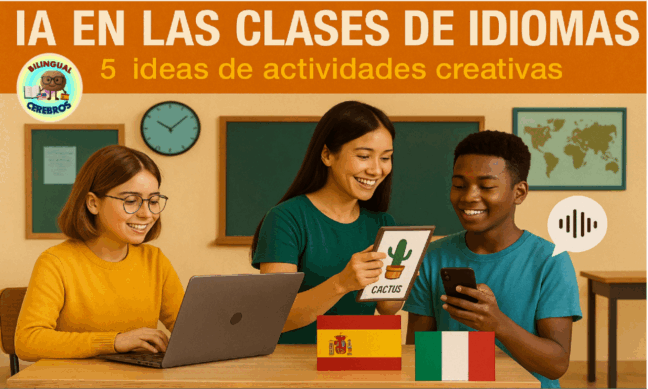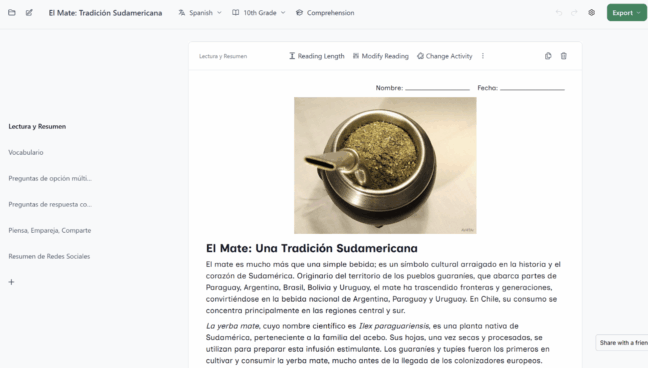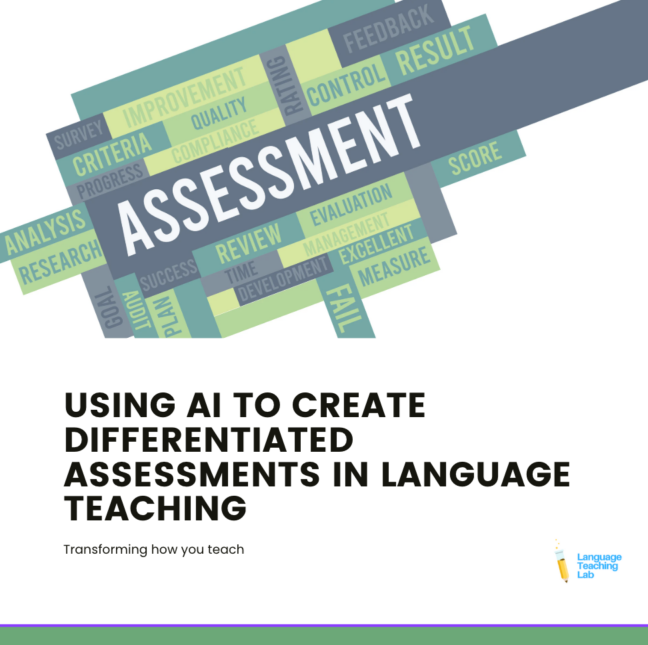by María Martínez (LTL Contributor)
Artificial Intelligence is changing the way we learn, teach, and interact with languages. For many educators, this shift brings a mix of curiosity and concern: Can AI really support language learning? Will it replace authentic communication? The truth is that, when used mindfully, AI can be a powerful ally — not a threat — in our mission to help students connect, communicate, and grow as bilinguals.
AI From Translation Tool to Communication Partner
AI tools like ChatGPT, Duolingo Max, or voice assistants can simulate conversations in different languages, giving students safe, judgment-free spaces to practice. Unlike traditional drills, AI-powered dialogues adapt to the learner’s level, tone, and pace.
Try this activity:
Ask students to “chat” with an AI tool in the target language about a topic from
class (e.g., “Describe your dream vacation”).
Then, have them reflect on vocabulary they used, what felt easy or hard, and
how the AI responded.
Finish with a real human conversation using the same topic — helping
students bridge AI interaction with authentic communication.
In this video I have described 5 creative activities using AI that you can use in your
lessons:
English version: https://youtu.be/ZuTqA1qNUYM
Spanish version: https://youtu.be/6buBCrLkKnU
AI Mindful Use: Teaching Digital and Linguistic Awareness
AI isn’t perfect. It may produce errors, cultural mismatches, or overly simplified responses. That’s where teachers remain essential. We can guide learners to question, compare, and reflect — turning AI into a thinking partner, not a final authority.
AI and Connecting Brains, Languages, and Humanity
At Bilingual Cerebros, we often talk about how bilingualism isn’t just about knowing two languages — it’s about connecting two ways of seeing the world.
AI can help us access more input, receive feedback, and practice anytime. But it’s our human creativity, empathy, and curiosity that turns language into connection. As teachers, our role is not to compete with AI but to humanize it — to use it as a bridge that brings learners closer to authentic expression and intercultural understanding.
La IA como aliada del aprendizaje de lenguas: lo que los docentes deben saber (y cuidar)
La Inteligencia Artificial está transformando la manera en que aprendemos y enseñamos idiomas. Para muchos docentes, esta revolución tecnológica despierta curiosidad, pero también cierta inquietud: ¿Puede la IA realmente ayudar en la adquisición de lenguas ¿Reemplazará la comunicación humana?
La respuesta es que, si se usa con criterio, la IA puede ser una gran aliada — no una amenaza — para fomentar la comunicación, la creatividad y el aprendizaje significativo.
De herramienta de traducción a compañera de conversación
Herramientas como ChatGPT, Duolingo Max o los asistentes de voz permiten mantener conversaciones simuladas en distintos idiomas, ofreciendo un entorno seguro y sin juicios. Estas interacciones se adaptan al nivel, tono y ritmo de cada estudiante.
Sugerencia de Actividad:
Pide a los estudiantes que mantengan una breve conversación con una herramienta de IA sobre un tema del aula (por ejemplo: Describe tus vacaciones ideales).
Luego, reflexionen sobre el vocabulario utilizado, las dificultades y la coherencia de las respuestas.
Finalmente, realicen una conversación real entre compañeros sobre el mismo tema — conectando la práctica con IA con la interacción humana.
En este video describe 5 actividades creativas usando IA que puedes usar en tus clases:
Versión en español: https://youtu.be/6buBCrLkKnU
Versión en inglés: https://youtu.be/ZuTqA1qNUYM
Uso consciente: enseñar conciencia digital y lingüística
La IA no es infalible. Puede cometer errores, omitir matices culturales o simplificar en exceso. Por eso el papel del docente es fundamental: guiar, comparar, cuestionar y reflexionar. Así, la IA se convierte en una compañera de pensamiento, no en una fuente
absoluta.
Conectando cerebros, lenguas y humanidad
En Bilingual Cerebros hablamos a menudo de cómo el bilingüismo no se trata sólo de saber dos idiomas: se trata de conectar dos formas de ver el mundo.
La IA puede ayudarnos a acceder a más información, recibir retroalimentación y practicar en cualquier momento. Pero es nuestra creatividad, empatía y curiosidad las que convierten el lenguaje en conexión. Como docentes, nuestro papel no es competir con la IA, sino humanizarla: utilizarla como un puente que acerque a los estudiantes a la expresión auténtica y al entendimiento intercultural.


